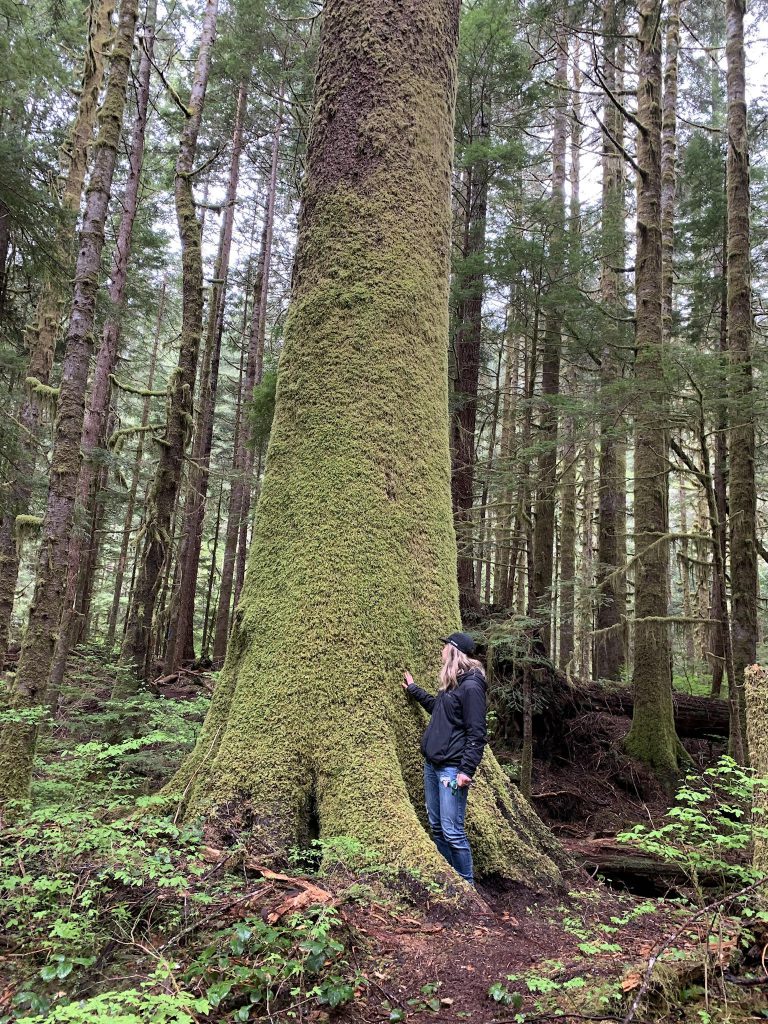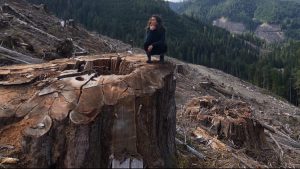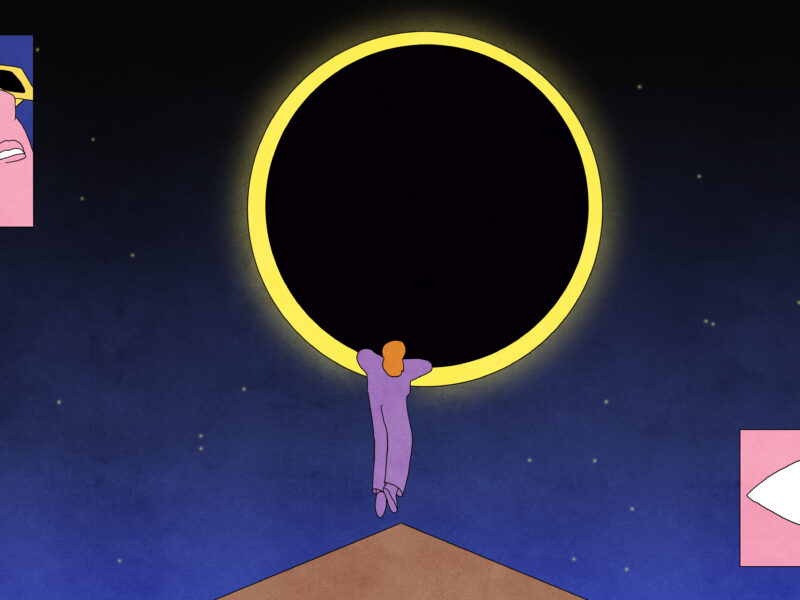For corporate loggers, millennia-old forests are just land that should be exploited and trees that can be replanted.
Holly Friesen has spent most of her life documenting nature’s beauty. The Montreal-based landscape artist recently spent some time in British Columbia as the Artist in Residence at Eden Grove on Vancouver Island, and was awe-struck by the stunning ancient forest.
“The air was thick with moisture and dense silence and the forest was dripping with a thousand shades of green,” she said. “Giant cedars, Douglas fir and Sitka spruce were thrumming with life, some of them 1,000 years old and more.”
The Eden Grove protection camp, established in 2020 to prevent road building by the Teal-Jones logging corporation, is five minutes from the residency. The corporation is currently locked in a months-long dispute with forest protectors at Fairy Creek, a nearby old-growth watershed.
Moved by the forest’s beauty, Friesen auctioned off a large painting she made of Eden Grove, with all the money going toward the Fairy Creek blockades. “These forests help us to remember who we are and where we come from,” she says. “Their protection for future generations is essential. This is sacred land.”

Some, however, don’t see anything holy here. For them, millennia-old forests are just land that should be exploited and trees that can be replanted.
A growing environmental movement
At the heart of the Fairy Creek dispute is, on one hand, a logging company that wants to exploit the land in what it claims is a sustainable way and, on the other, environmental protectors who don’t believe that profit should come at the expense of these precious ecosystems. A group that calls themselves the Rainforest Flying Squad has blockaded the watershed on unceded Pacheedaht First Nation’s territory for the past 10 months. Their goal is simple: to stop Teal-Jones from cutting down rare intact old-growth forest. Protesters have been camped here since last summer, demanding that the provincial government put an immediate end to old-growth logging and transition to an ecologically responsible forest economy.
View this post on Instagram
The movement to protect these ancient forests is not new, but it was the widely shared photo of a massive, ancient spruce tree being hauled down Vancouver Island on a flatbed truck that garnered international publicity. Even those least inclined to label themselves tree-hugging environmentalists knew there was something wrong with a tree older than many of the world’s most famous historic landmarks being reduced to a lifeless stump in order to supply lumber for someone’s deck. Lorna Beecroft, the woman who took the photo and posted it on her Facebook wall, said: “It’s like watching someone shoot the last dodo.”
The international outrage attracted the support of Hollywood celebrities and activists. Marc Ruffalo and Leonardo di Caprio recently used their online platforms and considerable media clout to raise awareness. Margaret Atwood, Bryan Adams, Jane Fonda, and Greta Thunberg were among the 100 prominent people who signed a letter calling on John Horgan, the premier of British Columbia, to stop old-growth logging. The letter begins: “Some things can’t be replaced.”
The crux of the dispute
Renowned for its natural, untamed beauty, British Columbia is home to 60 million hectares of temperate coastal rainforest. The provincial government claims that 25 percent of the province’s forests are composed of old-growth trees; but the Old Growth Strategic Review, an independent study commissioned by the government in 2020, found that only 3 percent of the province is capable of supporting large trees. Within that small portion, old trees represent only 2.7 percent. Logging has cannibalized the ancient forests.
“These ecosystems are effectively the white rhino of old-growth forests. They are almost extinguished and will not recover from logging,” concluded the authors of the report from Veridian Ecological Consulting.

Old-growth forests cannot be replaced because replanted forests—referred to as second growth—do not recreate the rich conditions and biodiversity of the ancient trees. The study urged the government to “immediately place a moratorium on logging in ecosystems and landscapes with very little old forest.” The Union of British Columbia Indian Chiefs also passed a resolution last year calling on the government to do the same.
Fairy Creek’s 12.8 hectares of unlogged ancient old-growth forests are in fact extremely rare, making up less than 1 percent of what remains in the province. And yet, despite their importance and rarity, these ancient trees are still being cut down. Teal-Jones still has government approval to log in mostly old-growth forests.
The Supreme Court of British Columbia granted an injunction in April for the RCMP to come in and remove protesters and tree-sitters at a string of blockades on logging roads in the area. Over 185 people have so far been arrested, but Canada’s legacy media has given the story little coverage. Independent media outlets Ricochet and The Narwhal have filled the vacuum.
Teal-Jones has set up a roadblock of its own to block media and public access to Waterfall Camp. Reports from the frontlines and from independent media outlets confirm that the RCMP are preventing access to accredited media and legal observers, as well as Indigenous leaders on their own lands. The Canadian Association of Journalists, along with a coalition of news organizations and press freedom groups, announced last week that it’s taking the RCMP to court over its decision to restrict media access.
Chainsaw massacre
Fairy Creek is near Port Renfrew, a tiny community that touts itself as the “Tall Tree Capital of Canada.” The area includes the world’s largest Douglas fir and Canada’s largest Sitka spruce, as well as endangered animal species like Western screech owls, Northern Goshawk, and Northern Red-legged frogs. The residents have built up a recreational tourism brand with its tree tourism, a reminder that conservation and commerce can coexist successfully. With proper infrastructure and policies in place, these beautiful trees can be worth more to the local economy standing than cut down.
“I moved to BC after taking one of these big-tree tours and I live here because of their beauty,” says Michael Simkin, a lawyer originally from Montreal. “I can understand the intellectual tension between the access provided to these areas because of logging, and the consequences of logging. I understand that many people’s livelihoods depend on this industry.” Simkin insists the issue is complex and involves many angles: economic, cultural, environmental, employment, social, and climate change, as well as Indigenous land claims. “But factually speaking,” he said, “There just aren’t many of these trees left, and once they’re gone, they’re gone.”
It’s not hard to see why so many people are invested in protecting them. Pictures of old-growth forests are mesmerizing. The soaring height of these trees gives visitors some perspective on the tiny importance humans have on this planet. Images of massive tree trunks chopped down, with humans looking like tiny Lilliputians next to them, only add to the looming sense of devastation.
Growing resistance
Premier Horgan promised to implement the Old Growth Strategic Review Panel’s 14 recommendations to work with Indigenous leaders and environmental organizations during his electoral campaign. More than a year later, none of those proposed changes have been fully implemented.
“In fact,” says Simkin, “old-growth logging permits have increased by close to 50 percent in the past few years.”
The government’s failure to act has sparked widespread resistance by long-standing local environmental protection agencies. Among them, the Ancient Forest Alliance, a non-profit that aims to enact province-wide legislation ending the logging of endangered old-growth trees, and Stand.earth, a Vancouver-based environmental advocacy organization. Tzeporah Berman—Stand.earth’s International Programs Director—was among the people recently arrested for defending old-growth forests near Fairy Creek headquarters.
In early June, tired of the inaction, the Pacheedaht, Ditidaht, and Huu-ay-aht First Nations formally gave notice to the province to defer old-growth logging for two years in the Fairy Creek and Central Walbran areas while the nations prepare resource management plans.
“For more than 150 years they have watched as others decided what was best for their lands, water, and people,” they wrote in their statement. The BC government, under increasing pressure, agreed on June 9 to a two-year moratorium on logging in the Fairy Creek watershed and Central Walbran areas. Land protectors see this as a good first step, but they are pushing for more permanent solutions.
We’ve lost our connection to nature
Amy Iredale is a kindergarten teacher in Cumberland on Vancouver Island. She teaches nature kindergarten, which means that her students do at least 50 percent of their learning and growing outside in the forests surrounding the schools. She has spent time at the blockades and has also raised awareness and funds for those on the front lines.
Seeing the area through the eyes of children has given her a newfound appreciation for the forests. “Children have this innate connection to the natural world around them that so many of us adults have lost,” she says. “Spend a day in the forest with a five-year-old and you will notice and learn more than you have in a long time. This connection, for whatever reason, is severed as we grow up.”
Iredale and her class spend most of their time in their Cumberland second-growth community forest, a forest that was protected after millions of dollars of fundraising and decades of community love and support.
“This is a community that was built on coal mining and logging,” she explains, “but they also understand that forests provide much more value standing, they are not anti-logging, they’re pro-balance.”
This great, big, interconnected world
Ross Reid, an outdoor adventure sports filmmaker, runs a popular website, Nerdy About Nature, where he combines his passion for nature with his storytelling skills. In his videos, Reid educates and motivates people to protect their surroundings. He believes that it’s possible to be both pro-logging and pro-environment. The fight isn’t “loggers vs. environmentalists” but “people versus systemic wealth, power and greed.” The goal, he says, should be to create sustainable forest management with Indigenous and local communities for the long-term benefit of everyone.
Reid emphasizes that, beyond their beauty, old-growth forests are vital for mitigating climate-related disasters like flooding, droughts, fires, and heatwaves. Clearcutting exacerbates heatwaves and increases the number and size of forest fires. It also increases the risk of flooding, erosion, and landslides. By protecting endangered old-growth forests, restoring intact forests, and reforming forest management, the government can support the health and safety of communities by mitigating climate-related disasters before the climate crisis worsens.
“I’d say the most crucial thing we all need to understand about these forests is that they are so much more than just the trees,” he says, when I ask what his most vital message is about Fairy Creek.
“They are complex, intricate, integrated and interconnected ecosystems that have evolved over millions and existed for thousands of years, whose functions are so far beyond the scope of our comprehension that we’re only just now beginning to scratch the surface of understanding their role in the grand scheme of life on this planet. We can’t even begin to understand the way that our actions will impact the rivers, the waters, the hydrological flows across both micro and macro climates for the next few thousand years to come.”
He worries that many can’t see the forest for the trees.
“Considering that our ‘modern society’ is only a couple hundred years old and that our calendar alone is only 2021 years old, when we cut these ecosystems down, we are literally erasing them from the planet forever, in human time-scale terms, and replacing them with tree plantations that we expect to grow back on 70-year rotations, essentially creating a cornfield where a forest used to be.”
“This,” he says, “jeopardizes the ability for life on this planet to survive— including ours.”
If you would like to add your voice to those calling for a stop to old-growth logging, Greenpeace Canada has compiled a handy list of 12 ways you can do so. You can find it here.



